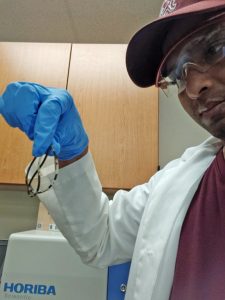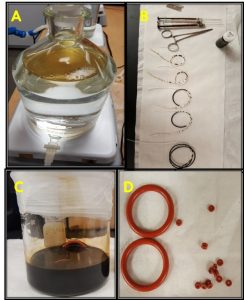Study Finds Passive Dosing Techniques May Simplify Oil Toxicity Tests
– MAY 21, 2019
Scientists evaluated two oil risk assessment protocols that use passive dosing to create oil and water accommodated fractions (WAFs) for laboratory tests as potential alternatives to the traditional oil dosing method that CROSERF (multi-agency/organization oil spill research group) recommends. Overall, measurements of dissolved hydrocarbon concentrations and compositions for all dosing methods were consistent and agreed with toxicity model predictions, which correlated with observed estimated oil equivalent (EOE) and biomimetic solid-phase microextraction (SPME) measurements. The results suggest that passive dosing may be a practical alternative for delivering and maintaining dissolved oil concentrations and reducing oil droplet dynamics, which can complicate oil exposure characterization and test interpretation.
The researchers published their findings in Environmental Toxicology and Chemistry: Passive dosing yields dissolved aqueous exposures of crude oil comparable to the CROSERF (Chemical Response to Oil Spill: Ecological Effects Research Forum) water accommodated fraction method.
The concentration levels of oil compounds, of which there are thousands, determine if the presence of oil or chemically-dispersed oil is at an environmentally toxic level. Therefore, risk assessment studies that include simulating oil exposures and measuring oil compounds affect the interpretation of toxicity data, especially if exposures are characterized differently across studies.
To encourage more standardized laboratory toxicity test procedures and the development of appropriate oil spill risk assessment protocols, a working group from Federal and state government, academia, and industry formed CROSERF (Chemical Response to Oil Spill: Ecological Effects Research Forum) to exchange ideas and coordinate research. The forum proposed a low-energy method to create WAFs that limited oil droplet formation in WAF preparations so that hazard characterization would focus on dissolved oil components (compared to the high-energy WAF which contain high concentrations of oil droplets that are unstable over time). This improved method reduced the dynamic behavior of oil droplets, which then reduced variability in analytical measurements.
This study’s research team sought to enhance this advancement by investigating if passive sampling could offer an analytical surrogate for toxicity prediction that would involve a simpler procedure than the CROSERF method and further reduce the variability of oil droplet dynamics. Using fresh Macondo oil dosed at 30 mg/L, the team compared the CROSERF method (physically disperses oil directly into water) with two passive dosing methods. One method added test oil into medical-grade silicone tubing that was then tied on both ends, introduced into the aqueous test media, and stirred to produce WAFs. The second passive dosing method used O-rings soaked in oil that were similarly introduced into the aqueous test media and stirred to produce WAFs.
The team used fluorometry-derived EOEs to monitor oil dissolution kinetics, gas chromatography-mass spectrometry to measure oil compound concentrations, SPME to measure dissolved oil, and the PETROTOX model to predict the WAF toxicity. Then they plotted the toxic units calculated for each WAF loading against biomimetic SPME and EOE measurements.
The two passive dosing methods generated aqueous media with dissolved oil compositions that were consistent with model predictions and comparable to the physical mixing that the CROSERF method used, especially for 2-ring polycyclic aromatic hydrocarbons. The observed linear correlation between biomimetic SPME measurements and the predicted toxic units across all three WAF methods and a potential correlation with EOE measurements suggest that EOE and biomimetic SPME could potentially serve as new exposure metrics in oil toxicity testing.
“Passive dosing provides greater accuracy in controlling dissolved oil exposures that facilitate toxicity test interpretation and the development of mechanistic effect models that link oil composition to adverse effects,” said study author Gopal Bera. “This work advances the application of passive dosing developed for single chemicals to complex oils and demonstrates the ability to maintain stable oil exposure concentrations. Passive dosing and the new biomimetic SPME and EOE analytical tools that target dissolved oil exposures represent an important step forward in standardizing our ability to accurately assess the hazards that oils pose to the aquatic environment.”
Future applications of passive dosing include use in comparison of different oil and the same oil in different weathering states and in-vitro oil toxicity testing.
Data are publicly available through the Gulf of Mexico Research Initiative Information and Data Cooperative (GRIIDC) at doi:10.7266/N7833QG1.
The study’s authors are Gopal Bera, Thomas Parkerton, Aaron Redman, Nicholas R. Turner, D. Abigail Renegar, Jose L. Sericano, and Anthony H. Knap.
By Nilde Maggie Dannreuther and Stephanie Ellis. Contact maggied@ngi.msstate.edu with questions or comments.
************
This research was made possible in part by a grant from the Gulf of Mexico Research Initiative (GoMRI) to Texas A&M University and Nova Southeastern University for their project Deep-sea Risk Assessment and species sensitivity to WAF, CEWAF, and Dispersant.
The Gulf of Mexico Research Initiative (GoMRI) is a 10-year independent research program established to study the effect, and the potential associated impact, of hydrocarbon releases on the environment and public health, as well as to develop improved spill mitigation, oil detection, characterization and remediation technologies. An independent and academic 20-member Research Board makes the funding and research direction decisions to ensure the intellectual quality, effectiveness and academic independence of the GoMRI research. All research data, findings and publications will be made publicly available. The program was established through a $500 million financial commitment from BP. For more information, visit https://gulfresearchinitiative.org/.
© Copyright 2010-2019 Gulf of Mexico Research Initiative (GoMRI) – All Rights Reserved. Redistribution is encouraged with acknowledgement to the Gulf of Mexico Research Initiative (GoMRI). Please credit images and/or videos as done in each article. Questions? Contact web-content editor Nilde “Maggie” Dannreuther, Northern Gulf Institute, Mississippi State University (maggied@ngi.msstate.edu).







